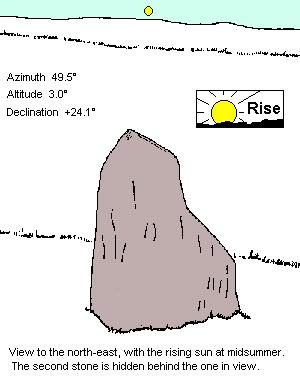
Clochkeil standing stones, Kintyre
Stones
of Wonder
QUICK LINKS ...
HOME PAGE
INTRODUCTION
WATCHING
THE SUN, MOON AND STARS
THE
MONUMENTS
THE
PEOPLE AND THE SKY
BACKGROUND
ARCHAEOASTRONOMY
USING
THE SITE DESCRIPTION PAGES
VISITING
THE SITES
THE
LEY LINE MYSTERY
THE
SITES
ARGYLL
AND ARRAN
MID
AND SOUTH SCOTLAND
NORTH
AND NORTH-EAST SCOTLAND
WESTERN
ISLES AND MULL
Data
DATES
OF EQUINOXES AND SOLSTICES, 1997 to 2030 AD
DATES
OF MIDSUMMER AND MIDWINTER FULL MOONS, 1997 to 2030 AD
POSTSCRIPT
Individual
Site References
Bibliography
Links
to other relevant pages
Contact
me at : rpollock456@gmail.com
Standing Stone Alignment NR658244*
How to find : The site is on the east side of the sand dunes of the Machrihanish links. It may be approached by the minor road which passes the closed RAF base and Clochkeil farm, then across the field to the dunes, which are just visible from the road; or you may park in the beach car park at Westport (655263) and have a walk of 1.5km down the beach before cutting across the dunes to the site. The monument is in a hollow, and not obvious if approaching from the beach side, until you are very close to it.
Best time of year to visit : Summer solstice, about June 21st.
This attractive and unusually situated site originally consisted of three standing stones set in a line. The northernmost stone has fallen and become buried in the sand, though you may be able to see one end of it still exposed. The other two stones, measuring 1.9 and 1.2m high, remain standing. The alignment is NE - SW, though the southern stone has its long axis at right angles to the line. The immediate topography of the site (which consists of sand dunes) will have changed since prehistoric times.


To the north-east the sun at midsummer rises over a flat-topped hill less than 2km away, while to the south-west the setting midwinter sun sinks behind Ireland, which is about 40km away across the North Channel, and perfectly visible on a clear day. The stones do not indicate this midwinter line accurately, and the midsummer line is likely to be the one intended. There is a similarity here with the monument at Ballochroy, where the stones are set at right angles to the alignment itself. This is not likely to be simple coincidence.
A calm day in winter is much the most likely time to see the coast of Antrim.